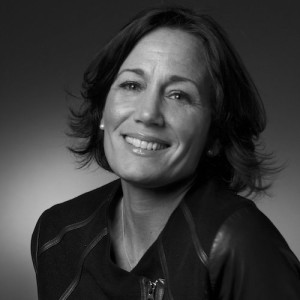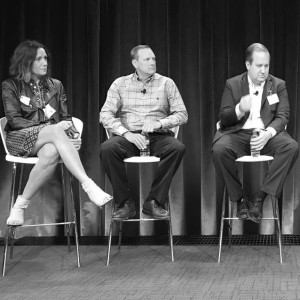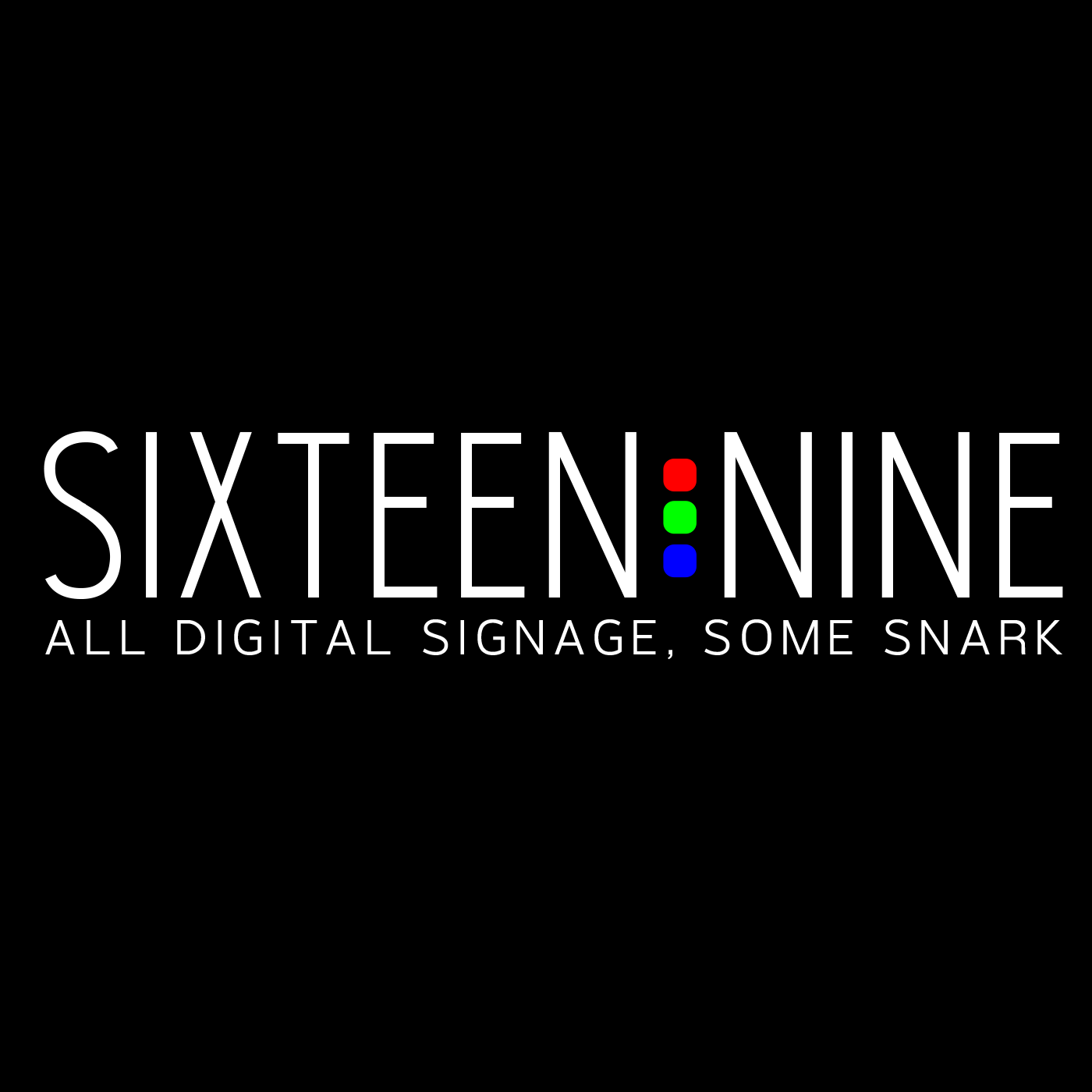Episodes

Wednesday Dec 19, 2018
Kim Sarubbi, Cannabis Medical Network
Wednesday Dec 19, 2018
Wednesday Dec 19, 2018
Screens in medical waiting rooms is one of the most well established kinds of digital OOH media, and there's been no end of companies that developed networks built around advertising-supported content.
That's now happening in the United States with medical cannabis clinics, through a pair of signage industry vets who have applied what they learned in mainstream medical centres to clinics focused on cannabis products - as alternatives to things like opioid medications.
Kim Sarubbi has been working with Phil Cohen on medical center content for a quarter century, and answered Cohen's call when he said he was getting back into waiting rooms aimed at the emerging cannabis market, via the Cannabis Medical Network.
They are already in roughly 1,000 clinics with a screen, media player and custom-created content that's designed to educate patients about the potential benefits of cannabis for battling things like PTSD or easing the pain or effects of cancer, epilepsy or other diseases.
I spoke with Sarubbi about the challenges of operating in a still emerging industry and market where the rules can vary, the product gets looked at with raised eyebrows, and the snake oil crowd can easily intermingle with the makers of much more proven and established products and treatments.
Subscribe to this podcast: iTunes * Google Play * RSS

Wednesday Dec 12, 2018
Kaan Gunay, Firefly
Wednesday Dec 12, 2018
Wednesday Dec 12, 2018
There's nothing new about media on taxi tops, but a San Francisco start-up called Firefly is trying to go about it with a different approach.
Firefly describes itself as the first mobility-based SmartScreens platform - an advertising media firm that gets it footprint and scale from the rideshare industry.
Firefly is working primarily with the drivers for services like Uber and Lyft, offering a supplemental revenue stream in return for fixing a hyper-local, geo-fenced digital sign on the cartop. Firefly absorbs the capital cost, and spins off an average of $300 a month to the driver. That money isn't huge, but it can be enough to significantly offset leasing or insurance costs and make driving for a living worthwhile.
Co-founder Kaan Gunay is a mechanical engineer by training, but in recent years has found his way to Stanford, where he got his MBA and where the roots of Firefly first developed. He's also very active in community good works, and we spoke about how continuing that was, and is, fundamental to how Firefly does things.
At least 10 percent of all media on screens goes to to promote and advertise local not-for-profit organizations and provide public service announcements for non-commercial entities such as charities.
The car-toppers have sensors - for things like air quality - that generate data that's open for government planners, and others, to use.
I spoke with Gunay last week, just as his company was announcing a big $18.5 million seed funding raise.
Subscribe to this podcast: iTunes * Google Play * RSS

Wednesday Dec 05, 2018
Kaijus Asteljoki, Valotalive
Wednesday Dec 05, 2018
Wednesday Dec 05, 2018
Workplace communications is one of the most active verticals in digital signage, and a big reason for that is the ability of screen technology to get important information to staff - without hoping they open and read mass emails or see posters on breakroom cork boards.
The Finnish startup Valota saw the rise in business-based digital signage coming, and has been developing a product totally focused on visual messaging in the workplace.
Based outside Helsinki, the company's Valotalive product is a messaging platform built around a growing set of content presentation apps that visualize data from widely used business systems like Salesforce and Microsoft's Power BI.
The platform enables set it and forget it content that's fed via these systems - so when the KPIs for a company change, they change automatically on screens located around facilities. It's a big step up from Happy Birthday wishes and notices about the parking lot being paved on the weekend.
I spoke with CEO Kaijus Asteljoki about the roots of Valotalive, and what he says are the key things end-users need to think about when putting together a digital screen network for their workplaces.
Subscribe to this podcast: iTunes * Google Play * RSS

Wednesday Nov 28, 2018
Ryan Croft, TransitScreen
Wednesday Nov 28, 2018
Wednesday Nov 28, 2018
This is inadvertently turning into transit digital signage month on this podcast, having spoken lately with CHK America about epaper transit signs and just last week with Roadify, which aggregates data from transit systems.
This week I'm talking to Ryan Croft, one of the co-founders of TransitScreen, which has made a mark in North America and globally with a subscription service that puts together and presents on screens all the mobility options for people at specific venues.
What that means in practical terms is people coming down in late afternoon to the lobby of their office block, and looking at a carefully-considered and laid-out screen that shows everything from the state of local buses and trains to the availability of Uber, Lyft and some of the other alternative transport options out there these days.
In our chat, we get into how TransitScreen got started, what they've learned along the way, why they've now added a mobile app, and how the sort of data insights all this mobility data is generating might have some interesting new uses.
Subscribe to this podcast: iTunes * Google Play * RSS

Wednesday Nov 21, 2018
Scott Kolber, Roadify
Wednesday Nov 21, 2018
Wednesday Nov 21, 2018
Mass transport data is some of the stickiest content out there for digital signage screens. It's information people tend to want and need, and they'll habitually look at screens to get it.
Tapping into the open data from one transport authority, to show it on screens, is relatively easy. It gets more complicated when you want to show data from multiple systems on a screen, and it gets quite complicated when the signage network wants to run data specific to different cities and different transit systems.
It would be a bear for a software or solutions company to take on, which is the attraction of a Brooklyn-based service called Roadify - which aggregates all that data from different systems and presents it all in one structured format, using its platform and running off a subscription model.
The service is similar to some of the news, weather and sports feed aggregators that have long operated in this sector, except the content is quite different. I spoke with founder and CEO Scott Kolber about the roots of Roadify, and how his company's services are being used.
Subscribe to this podcast: iTunes * Google Play * RSS

Wednesday Nov 14, 2018
Beth Warren, Creative Realities
Wednesday Nov 14, 2018
Wednesday Nov 14, 2018
Beth Warren of Creative Realities - or CRI for short - came recommended as a speaker for the DSF's recent Coffee and Controversy event in New York.
We'd never met, and while in New York, I seized the opportunity to meet up with her after the event to talk a lot about digital signage in retail - from her longtime lens as the Senior VP of Experience Planning at CRI.
She comes out of the agency world, so she approaches signage in retail from a different perspective and set of learned experiences and observations. We go fairly deep in our chat into what experience actually means - and what genuinely works in retail, versus some of the trickery and gadgets that get touted as delivering "engagement."
We also get a little into what CRI does, and the many twists and turns of its recent history. The company has evolved, and now positions itself very much as a solutions provider that can take retailers from the need and idea through to lighting up the visuals and measuring the impact.
Subscribe to this podcast: iTunes * Google Play * RSS

Wednesday Nov 07, 2018
2018 DSF Coffee and Controversy, in NYC
Wednesday Nov 07, 2018
Wednesday Nov 07, 2018
I was in New York last week for the Digital Signage Federation's annual Coffee and Controversy breakfast event - a panel discussion that each year brings together some of the most influential leaders in the digital signage industry.
I'm on the DSF board and my fellow board members drafted me to run the panel - with Chris Riegel of STRATACACHE, Jeff Hastings of Brightsign and Beth Warren of Creative Realities.
There's only so much controversy you can whip up around digital signage, but I tried ... and if anyone in this industry was going to stir up some shit, it was Chris. He didn't disappoint, nor did Jeff or Beth.
The women who ran the AV for the event very kindly generated an audio recording for me. This is about twice the length of a normal 16:9 podcast, but if you didn't have the chance, time or budget to get to New York last week, you can have a listen to what was said.
Subscribe to this podcast: iTunes * Google Play * RSS

Wednesday Oct 24, 2018
Rick Wood, CHK America
Wednesday Oct 24, 2018
Wednesday Oct 24, 2018
Rick Wood's company was founded to bring some order and logic to how mass transport systems present information - like routes and schedules - to passengers.
It was a tall order for CHK America - because many or most transport authorities had their own way of doing things, and not that many were particularly good at making it easy and familiar for people to find their way around.
But the company has seen a lot of success, and its best practises have been widely adopted. When people take unfamiliar buses and subways in cities they visit, there's a reasonable chance the information on the signs they see now look familiar and can be readily understood. Ideally, CHK says people should be able to find out what they need in eight seconds.
It's a mindset smart digital signage people have come to understand ... in essence, you have a matter of a few seconds to inform people before they look somewhere else.
All the understanding of how people seek and consume information is now being applied by CHK, through a spinout called ConnectPoint, to digital displays. The company started with big interactive screens, but now the really interesting work is with dynamically-updated, solar-powered e-paper signs at bus stops.
In this week's podcast, I spend a lot of time talking to Wood about how mass transit users find and use information, and how all this translates from static to digital displays.
Subscribe to this podcast: iTunes * Google Play * RSS

Wednesday Oct 17, 2018
Matt Downey, Freshwater Digital
Wednesday Oct 17, 2018
Wednesday Oct 17, 2018
Matt Downey's time in digital signage traces way, way back to the days when Premier Retail Networks was, by far, the big dog in putting screen networks in retail environments.
His time with PRN - working with clients like Walmart - eventually led him into working directly for one of his big grocer clients. Not long after that, he took a leap and started his own company. I'd say it was a big leap, but he started out with a whale client - his current employer.
Many years later, Freshwater Digital is a well established digital signage solutions provider, with double-digit growth every year and a client list that's rich in big companies that's not only local to Grand Rapids, Michigan, but also includes organizations that are much further afield.
Matt and I get into the roots of Freshwater, and lessons learned. We also go pretty deep into a new area he's going after in a big way - e-paper tags and shelf labels.
Subscribe to this podcast: iTunes * Google Play * RSS

Wednesday Sep 26, 2018
Mark Bennett, MicroGigantic
Wednesday Sep 26, 2018
Wednesday Sep 26, 2018
In an industry that has, for years, had people endlessly blabbering away about how Content Is King - my God that's clever! - it's amazing to me how I can count the number of pure-play digital signage creative shops on one hand.
MicroGigantic is one of those rare shops - a Minneapolis, Minnesota-based boutique agency that does visual storytelling for brands - whether that's retail or corporate.
The company's roots are with one of the biggest brands in the Twin Cities - the mass merchandising retailer Target. Mark Bennett managed the Media Production group at Target - and a big part of that was feeding the many screens sprinkled around the huge stores.
It was a great gig, Bennett says, but he got the seven-year itch to go out on his own, and started MicroGigantic knowing there wasn't a lot of competition for what he wanted to do.
His team does retail, but the real growth these days is for work in areas like corporate - with companies looking to make visual statements about what they do, and what they're about.
Subscribe to this podcast: iTunes * Google Play * RSS

Tuesday Sep 18, 2018
Hongwei Liu, Mappedin
Tuesday Sep 18, 2018
Tuesday Sep 18, 2018
Wayfinding is one of those core technologies that make consumer lives better and easier - helping people locate where they want and need to go in places like shopping malls, airports, health care facilities and higher ed campuses.
There are numerous software companies that include wayfinding capabilities in their platforms, but only a handful that have been laser-focused just on delivering that solution. One of the most successful ones is Mappedin.
The company started as a sideline for some students at the University of Waterloo, which most observers would call the top computing school in Canada. Hongwei Liu and his buddies thought they could solve a problem for students finding their way around the sprawling Waterloo campus, and then at a local mall and a casino a couple of hours up the highway.
There was enough there for Liu to quit school in his second year. Just a few years later, he's running a company with 60 employees, some big outside investors, and clients across North America and globally.
I spoke with Liu about Mappedin's roots, what works and doesn't, and how the big moment came when serious research showed good wayfinding can mean millions of dollars in incremental sales for shopping malls and their tenants.
Subscribe to this podcast: iTunes * Google Play * RSS

Wednesday Sep 12, 2018
From The Archive: Michael Schneider On Experiential Digital Design
Wednesday Sep 12, 2018
Wednesday Sep 12, 2018
No new podcast this week ... sorry.
I had two postponed interviews last week, combined with a short work week and then me spending two of those four days in a succession of airplanes getting to and from a client. I'm kinda remote now, and so are they.
I have two chats scheduled for Thursday, and more in the hopper. I'm also happy to get suggestions on people/companies I should be making subjects of an episode, so send your suggestions along.
That stated, it's an archive week. Enjoy this podcast chat from late 2016 with Michael Schneider, who was with the experiential design firm ESI Design at the time, but sent me a note last week to say he's joined the NYC office of the big, global architecture and design firm Gensler, as Creative Technology Director – Hardware.
He's left a great firm, but gone to another great one. Smart, soft-spoken guy, involved with some phenomenal projects.

Wednesday Aug 29, 2018
Refik Anadol, On Digital Data Sculptures
Wednesday Aug 29, 2018
Wednesday Aug 29, 2018
If finding a free half-hour to talk is any indication, Refik Anadol is one busy, popular guy right now. That likely owes a lot to the mind-blowing data visualization work he's been doing lately in public spaces.
He's a Turkish-born digital media artist who now has a busy studio in Los Angeles doing what he calls parametric data sculptures for public art spaces.
If you have been in downtown San Francisco, you may have seen a big LED video wall in the lobby of a Salesforce tower that seems to have a corner glass window with live expanding foam - or something. It looks real, but it's just three-dimensional digital art, driven by data.
More recently, he's done several sync'd up visualizations on the LED walls of an expanded section of Charlotte, North Carolina's airport. What's happening on the screens there is all based on real-time data from airport operations. So what you see on the screens is shaped by things like luggage-handling systems.
Kinda crazy.
I caught up with Anadol recently at his LA studio, to get a sense of what he and his team does, and we have a broader discussion about visualized data.
Subscribe to this podcast: iTunes * Google Play * RSS

Wednesday Aug 22, 2018
Pierre Gendron, Stingray Media
Wednesday Aug 22, 2018
Wednesday Aug 22, 2018
tingray Digital Media Group is one the world's biggest providers of multi-platform music services, with 11,000 commercial clients in 156 countries.
The Montreal company's core business is piped-in music channels for commercial and residential, but it also has a growing operation in digital experiences for retail - like flashy screen networks in big Canadian sporting goods stores.
That side of the business is led by Pierre Gendron, a former pro hockey player who found his way into digital signage doing an early version of it for company golf tournaments around Quebec. That company evolved and developed into Groupe Viva, which was then acquired in 2015 by Stingray.
Now part of a much larger organization, Gendron talks in this chat about what Stingray offers and how it intends to grow. One of those ways is through acquisition, and we get into why Stingray recently bought Toronto-based NovraMedia, which gives the company a big national bank customer and a stronger digital signage foothold in English Canada and beyond.
Subscribe to this podcast: iTunes * Google Play * RSS

Wednesday Aug 15, 2018
Kyle Pilot, iGotcha
Wednesday Aug 15, 2018
Wednesday Aug 15, 2018
I was in Montreal recently and had a chance to visit the offices of iGotcha, a digital signage and experiential media solutions company that has very quietly built up a nice book of business since launching in 2005.
Working out of an old warehouse building overlooking the historic Lachine Canal, iGotcha works with everyone from banks and a lottery corporation to Cirque du Soleil.
I caught up with Kyle Pilot, one of the co-founders and the longtime CTO. He now runs the company with business partners Greg Adelstein and Hadrien Bessou.
In this chat, we get into what they do, who they work with, and get on a fairly lengthy riff about the merits of technology like System on Chip displays.
Subscribe to this podcast: iTunes * Google Play * RSS

Wednesday Jul 11, 2018
Nick Fearnley, Signstix
Wednesday Jul 11, 2018
Wednesday Jul 11, 2018
I am guilty of thinking about SignStix as yet another smallish digital signage CMS company scratching out a living with low-cost subscriptions and equally low-cost Android stick players.
Based in Yorkshire, England, SignStix is a lot more than that. The company is indeed small, but doing some stuff that is a little bit mind-blowing. It does digital signage, but for some significant clients it is doing a lot of back-of-the-house data-mining and aggregation for communications that go beyond screens.
What I found really interesting is learning from CEO Nick Fearnley how the company is using the intelligence on system on chip "smart" displays to do things like manage and aggregate geo-fencing data from trucks moving in and out of a retailer's loading docks. It's stuff that would much more normally be done by full PCs, and it is completely counter to the suggestion still out there that these smart displays aren't all that bright.
Fearnley and I chatted at the back of one of the halls at InfoComm, last month in Las Vegas. You'll enjoy the chat, and particularly his Yorkshire accent.
Subscribe to this podcast: iTunes * Google Play * RSS

Wednesday Jun 20, 2018
Brett Jones, Lightform
Wednesday Jun 20, 2018
Wednesday Jun 20, 2018
One of the most interesting companies I saw recently at InfoComm in Las Vegas was Lightform, a San Francisco start-up that is making the once dark art of projection mapping available to just about everyone.
It wasn't that long ago that projection mapping was all about very ambitious, very complicated, very expensive projects that only a handful of companies had the chops to pull off.
Now we have a company with a $700 device and related software that makes it possible for just about anyone to do small-scale projection mapping on things like a merchandising display or a wedding cake.
Lightform calls this Projected Augmented Reality - the idea that AR is not something that needs to be seen though the lens of a smartphone.
I spoke with CEO and co-founder Brett Jones, and we did our best to describe to listeners what we were seeing as we walked around the booth.
Subscribe to this podcast: iTunes * Google Play * RSS

Thursday May 31, 2018
Arie Stavchansky, Dataclay
Thursday May 31, 2018
Thursday May 31, 2018
Anyone who works with creative teams knows there is no such thing as a content fairy. Video spots don't magically appear in inboxes overnight. Somebody had to design and render that video, and that work, frankly, takes a while.
So it's a little freaky to talk to a company that can do 1,000s of good-looking, customized videos in a matter of hours. But that's what Dataclay is all about.
The little company operating out of Austin, Texas has written the software and services that can mass-produce data-driven videos at pretty much the click of a mouse. And these aren't crappy, simplistic videos no one would want anyway. They come out of Adobe After Effects, full After Effects templates, and a plug-in written by Dataclay.
Imagine a national realtor being able to mass-produce a piece of video for every listing that comes into its databases - photos, details, the whole nine yards. Imagine a theme park spitting out videos instead of 8 by 10s that families can buy when they leave a ride or the park. Imagine a custom highlights video of every runner in a marathon ... kinda like this ...
I spoke with company founder Arie Stavchansky about how the platform he built brings automation and industrial-scale video production to digital signage, advertising and marketing.
Subscribe to this podcast: iTunes * Google Play * RSS

Wednesday May 16, 2018
Matt Gibbs, UPshow
Wednesday May 16, 2018
Wednesday May 16, 2018
A whole bunch of startups have through the years, tried to crack the restaurant and bar business with a digital out of home advertising model that saw them put in screens and media players, hoping to claw back the costs, and more, through advertising.
And a whole bunch of them - most of them, in fact, have failed. Advertising is hard.
So I was intrigued by a three-year-old Chicago company called UPshow that is doing user-generated content and digital signage in bars, and making a go of it on a subscription basis - with no third-party advertising. At least for now.
The bar owners - from small ones all the way up to chains like TGI Fridays and Hooters - actually pay money month to month for the service. The owner/operators like that UPshow's content is fresh, and human moderated, and that customers are engaged. They also like that it is selling more drinks and specials, and generating return business.
I spoke with Matt Gibbs, the company's CMO, and one of its co-founders.
Subscribe to this podcast: iTunes * Google Play * RSS

Wednesday May 02, 2018
Jason Bier, Federation For Internet Alerts
Wednesday May 02, 2018
Wednesday May 02, 2018
One of the time-honored lines used in digital signage and digital out of home media is how the technology gets the right messages to the right people at the right times.
That's all had to do with marketing and advertising, but a non-profit called the Federation for Internet Alerts has a mission to get crucial alerts in front of the right people at the right times and places to save lives and rescue kids.
Based on years of volunteer work from top coders, pro bono support from agencies and web services, and some grants here and there, the organization is sending critical alerts across North America that warn people about imminent threats like tornadoes, and more insidious threats like bad air.
Almost 1.5 million alerts have been processed since the platform started, and while most of that has been for web and mobile, now the organization is talking to digital out of home media companies about how its alerts could be on big digital screens that are everywhere, and always connected.
I spoke recently with the organizations founder and volunteer CEO, Jason Bier.
Subscribe to this podcast: iTunes * Google Play * RSS


